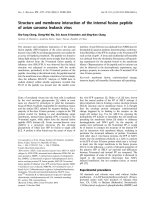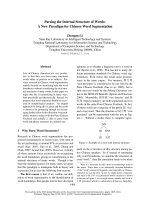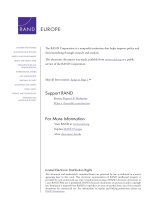Globalization the internal dynamic
Bạn đang xem bản rút gọn của tài liệu. Xem và tải ngay bản đầy đủ của tài liệu tại đây (2.08 MB, 387 trang )
GLOBALIZATION:
THE INTERNAL
DYNAMIC
..................................................
.............................................
.............................
Edited by
PAUL KIRKBRIDE
and KAREN WARD
JOHN WILEY & SONS, LTD
Chichester . New York . Weinheim . Brisbane . Singapore . Toronto
.GLOBALIZATION:
...............................
THE
. . . . . . . . . INTERNAL
...................
DYNAMIC
..................
GLOBALIZATION:
THE INTERNAL
DYNAMIC
..................................................
.............................................
.............................
Edited by
PAUL KIRKBRIDE
and KAREN WARD
JOHN WILEY & SONS, LTD
Chichester . New York . Weinheim . Brisbane . Singapore . Toronto
Copyright 2001 by John Wiley & Sons, Ltd,
Baffins Lane, Chichester,
West Sussex PO19 1UD, England
National
01243 779777
International (+44) 1243 779777
e-mail (for orders and customer service enquiries):
Visit our Home Page on
or
All Rights Reserved. No part of this publication may be reproduced, stored in a retrieval
system, or transmitted, in any form or by any means, electronic, mechanical, photocopying,
recording, scanning or otherwise, except under the terms of the Copyright, Designs and Patents
Act 1988 or under the terms of a licence issued by the Copyright Licensing Agency, 90
Tottenham Court Road, London W1P 9HE, UK, without the permission in writing of the
publisher.
Other Wiley Editorial Offices
John Wiley & Sons, Inc., 605 Third Avenue,
New York, NY 10158-0012, USA
WILEY-VCH GmbH, Pappelallee 3,
D-69469 Weinheim, Germany
John Wiley & Sons Australia, Ltd, 33 Park Road, Milton,
Queensland 4064, Australia
John Wiley & Sons (Asia) Pte Ltd, 2 Clementi Loop #02-01,
Jin Xing Distripark, Singapore 129809
John Wiley & Sons (Canada) Ltd, 22 Worcester Road,
Rexdale, Ontario M9W 1L1, Canada
British Library Cataloguing in Publication Data
A catalogue record for this book is available from the British Library
ISBN 0-471-49941-2
Typeset in 11/14pt Bembo by Dorwyn Ltd, Rowlands Castle, Hants.
Printed and bound in Great Britain by Biddles Ltd, Guildford and King’s Lynn.
This book is printed on acid-free paper responsibly manufactured from sustainable forestry, in
which at least two trees are planted for each one used for paper production.
CONTENTS
...........................
PREFACE
ix
Leslie Hannah
ACKNOWLEDGEMENTS
EDITORS’ INTRODUCTION
Paul Kirkbride and Karen Ward
Plan of book
1
xi
xiii
xv
GLOBALIZATION: WHERE IS YOUR
ORGANIZATION TODAY?
3
Paul Kirkbride, Paul Pinnington and Karen Ward
Globalization organization: myth or reality?
Problems and issues encountered when globalizing
What would a truly global organization look like?
3
24
31
vi C O N T E N T S
............................................................................
2
3
4
5
DESIGNING GLOBAL ORGANIZATIONS
43
Karen Ward
Barriers to global design
Designing for success
Conclusions
43
49
74
MANAGING ACROSS CULTURAL DIVIDES:
79
IS IT REALLY A PROBLEM?
Paul Kirkbride and Robert Westwood
What is culture?
Ten dimensions of cultural difference
Developing cultural sensitivity
Globalizing the leadership cadre
Is culture real or is it an excuse?
Conclusion: convergence or divergence?
81
84
99
102
105
108
ORGANIZATIONAL CHANGE IN THE
GLOBAL COMPANY: IS IT ANY
DIFFERENT?
115
Paul Kirkbride
The problem of scale
The problem of culture
Is ‘change’ a universal truth?
Conclusion
118
126
143
148
LET ME LEARN! A CHALLENGE TO THE
GLOBAL ORGANIZATION
155
Samreen N. Khan
What is the key challenge for the global learning
organization?
Where does the individual fit in?
How does an organization successfully learn in a global
environment?
Conclusion
159
168
179
187
CONTENTS
............................................................................
6
BUILDING A GLOBAL E-LEARNING
ENVIRONMENT
Cath Redman and Andrew Ettinger
What is a global e-learning environment?
Why develop a global e-learning environment?
Global e-learning: how do you create the best experience
for the learner?
The rise of the corporate university
Key success factors for global e-learning environments
7
8
9
193
196
200
203
211
213
WORKING IN COMPLEX TEAMS: ARE
YOU BUILDING GLOBAL CAPABILITY OR
223
DESTROYING IT?
Karen Ward
Why teams?
How to create successful complex teams
Best practices throughout a team’s life cycle
Conclusion
223
225
229
254
DEVELOPING GLOBAL LEADERS
259
Stefan Wills
‘Being’: differences or similarities?
‘Being’ as the head/heart/soul
Developing the head
Developing the heart
Developing the soul
261
262
263
267
276
LEADERSHIP AND THE GLOBAL
ORGANIZATION
285
Phil Hodgson and Randall P. White
Global leadership: what’s new?
Being motivated by mysteries
Being risk tolerant
Scanning ahead
Tackling tough issues
286
291
293
294
295
vii
viii C O N T E N T S
............................................................................
10
Creating excitement
Being flexible
Simplifying
Being focused
Conclusion
297
297
298
300
301
GRIPPING THE ROAD TO
GLOBALIZATION: DEVELOPING
LEADERSHIP COMPETENCIES AT
PIRELLI
305
Paul Kirkbride
The Pirelli Group
The Pirelli Leadership Programme
The Full Range Leadership model
The Pirelli Tyres (UK) programme
The workshops
Personal coaching
Follow-up activities
Evaluating the intervention: is the model culture bound?
306
307
309
316
318
320
321
322
APPENDIX A: GLOBAL ORGANIZATION
DIAGNOSTIC QUESTIONNAIRE
327
APPENDIX B: GLOBAL ORGANIZATION
MODEL SCORING SHEET
339
APPENDIX C: GLOBAL ORGANIZATION
MODEL RESULTS SHEET
341
AUTHOR BIOGRAPHIES
343
INDEX
354
PREFACE
......................
Since 1959 Ashridge has earned the reputation of being one of the
world’s leading business schools. Through all our activities, from executive education and post-graduate qualification programmes to research and consulting, we combine leading-edge thinking with a
strong practical focus. We believe that learning must be involving,
challenging and above all real, so that it does make a significant difference when applied in the workplace. To this end we have reinforced
and built upon the philosophy of our founders: that business needs to
inform and reflect the environment in which it operates. Our work
with clients and business school partners from all parts of the world
endorses this still further.
We know that globalization is not an isolated subject, as it integrates
with all organizational activities and as such creates fascinating business
and development opportunities. Our faculty’s expertise in globalization
has developed from research, observation, hands-on experience and
passion for the subject. We are therefore delighted that our faculty
members are able to share their learning and insights more widely by
contributing chapters to two complementary books published by John
Wiley & Sons.
x PREFACE
............................................................................
I hope you find that these two books Globalization: The Internal
Dynamic and Globalization: The External Pressures help you address your
own particular issues and I would be pleased to hear your thoughts and
comments on Ashridge’s approach to globalization.
Leslie Hannah
Chief executive
ACKNOWLEDGEMENTS
.........................................................
The original idea for this book and the companion volume (Kirkbride,
P.S. Globalization: The External Pressures, Wiley, 2001) came from Kate
Charlton, then Director of Corporate Development and Paul
Pinnington, Stream Director for Tailored Programmes. Kate and Paul
were convinced that Ashridge had a wealth of talent that could be
brought to bear on the topic of globalization and so the resulting works
owe a debt to their vision. They had initiated discussions with
publishers and Paul Kirkbride’s role, as newly appointed Research
Fellow, was to bring the books to fruition. Paul was solely responsible
for the first book but managed to recruit Karen Ward to help edit the
second book.
Editors of a collection such as this owe a debt of gratitude to the
individuals who volunteered to provide chapters, often having to fit
writing into a very busy teaching or consulting schedule. Thanks therefore to Paul Pinnington, Karen Ward, Bob Westwood, Samreen Khan,
Andrew Ettinger, Cath Redman, Stefan Wills, Phil Hodgson and
Randall White for their sterling contributions.
Paul would like to thank the following:
xii A C K N O W L E D G E M E N T S
............................................................................
● My secretary, Tracy Bowdrey-Long, for her usual efficient work
and for her calming influence;
● Rachel Oakley, from the Ashridge Graphics Department, for her
excellent work on the Figures for the book;
● Leslie Hannah, Chief Executive, for his support and encouragement;
● Karen Ward, for her involvement in the development of the book
and her constant encouragement and support despite the competing
time pressures of her pregnancy and subsequent maternity leave;
● Claire Plimmer and her team at Wiley for their expert advice and
assistance;
● Staff at the Australian Graduate School of Management (AGSM) in
Sydney, especially Dr Robert Westwood, for providing me with a
peaceful and relaxing venue to complete my own chapter contributions while teaching a summer school in January and February 2000;
● My many international clients, and the global managers within them,
who have shaped my view of globalization and the global organization;
● My children, Daisy, Holly and William, for support and encouragement
(as long as my writing did not intrude too far upon family activities!)
Karen would like to thank the following:
● Paul Kirkbride, for somehow getting me involved in this great project despite the fact I was already too busy and for chasing me for
deadlines in the gentlest way possible;
● David Findley, former HR Director GlaxoWellcome, who had the
courage to give me my first global role and the wisdom to help me
learn from that experience;
● Claudia Heimer and Kevin Barham for all the lunchtime and late
night chats about how the world really is in these global organizations;
● My wonderfully supportive husband, Martin, without whom I could not
balance a global job and being a mum to my boys Rian and Matthew;
● Last, but certainly not least, all the global leaders and their teams
whom I have had the pleasure of working with. Without you and all
we have learned together there would be nothing to write. Thank you.
Paul Kirkbride
Reading, August 2001
Karen Ward
St Albans, August 2001
EDITORS’
INTRODUCTION
................................................................
Paul Kirkbride and Karen Ward
If the shelves of airport bookstalls are any indication, the 1990s were
the decade of globalization. Whether in the fields of business, management, economics, information technology or e-commerce, the word
appeared to be on everyone’s lips. As a leading international business
school, Ashridge was not immune from such trends. The start of the
decade saw Ashridge adopt a clear strategy of internationalization, if
not globalization. It extensively expanded its work in continental
Europe as well as in Asia-Pacific and the United States.
In parallel with this move were several other trends within Ashridge. Obviously, ‘globalization’ began to be taught more frequently
on development programmes as a special topic, but also other parts of
the ‘curriculum’ began to take on a more global dimension. Members
of the Ashridge faculty were increasingly working with more ‘global’
clients and researching more into various aspects of globalization. For
example, in 1993 Paul Kirkbride organized the Third Conference on
International Personnel and Human Resources Management at Ashridge (Kirkbride, 1994). The theme for this conference was ‘Human
Resources Management in the New Europe of the 1990s’ and it dealt
xiv E D I T O R S ’ I N T R O D U C T I O N
............................................................................
with a number of globalization issues, including the role of national
cultures, the developments in the European Union, the growth of
Eastern Europe, and the creation of pan-European managers. Karen
Ward spent the late 1990s researching and working with international
project teams. This research project culminated in the production of a
new model of international team working (Canney Davidson and
Ward, 1999). Ashridge also began a deliberate process of ‘internationalizing’ the faculty that led, by the end of the decade, to a faculty
with very diverse cultural origins and working experiences.
However, part of the role of a high-quality business school is its
ability to take an objective and critical look at topics and processes that
might simply be passing managerial ‘fads’. Our view is that innovations
in terms of new concepts tend to go through two distinct phases. In the
first phase, which we term recognition, the new concept attracts a great
deal of attention. Many people jump on the conceptual bandwagon
and rush into print with books and articles seeking to elucidate the
concept. Managers rush to seminars and conferences to learn all about
the new concept and the implications for their own organizations,
often fearing that they may be missing out on something important. At
the end of this phase the concept is high in the popular consciousness.
Everyone has heard of it and has an opinion on it. However, while
much heat has been generated in the discussions and debates around the
topic, there is often not quite so much light. There are a number of
examples of this process in recent years, ranging from ‘lean manufacturing’ to ‘business process reengineering’ to ‘emotional intelligence’.
Our argument is that globalization is yet another example of this trend.
Indeed, we would argue that globalization is a particularly good example, as the globalization debate tended to get caught up within a
more general ‘fin de si`ecle’ or ‘millenniumist’ debate that saw globalization as the arrival of a new epoch in the twenty-first century.
The second phase of dissemination, which we term understanding, is more sober. Here the concept is held up to critical inspection
and evaluation in an attempt to distil its real elements. The protagonists
are not na¨ıve supporters of the idea but objective observers. It is our
contention that the concept of globalization is ripe for such a critical
reappraisal. This notion, plus the fact that many from within the
EDITORS’ INTRODUCTION
............................................................................
Ashridge faculty had been doing research, either pure or applied, into
aspects of the topic, led to the suggestion that they should pool their
thoughts in a book on globalization. As this idea was debated, two
distinct books emerged. The first, Globalization: The External Pressures,
was edited by one of us (Kirkbride, 2001), while we worked together
to write chapters for, and edit, this second book on the internal aspects
of globalization. Both books are the products of authors who are fulltime Ashridge faculty, recent Ashridge faculty and/or Ashridge
associates.
This volume, Globalization: The Internal Dynamic, focuses on what
it really takes to become a global organization. We essentially argue
that, despite the rhetoric, few organizations are really global or transnational. This volume thus seeks to understand what such organizations
would look like and the potential barriers to true global status. It offers
practical advice in terms of what organizations would have to do to be
really global in nature. The companion volume, Globalization: The
External Pressures (Kirkbride, 2001), seeks to examine the concept of
globalization and the existence of global financial and labour markets.
It looks at the pressures towards globalization and at how organizations
are responding on a macro scale and, in terms of their external interfaces, with an increasingly global environment.
PLAN OF BOOK
In Chapter 1 Paul Kirkbride, Paul Pinnington and Karen Ward, all
from Ashridge, seek to examine whether the much hyped ‘global’
organizations exist in reality or are simply a myth fed by hyperbole and
an overexcited managerial literature. They suggest that a number of the
supposed drivers of this process are found to be wanting under a critical
spotlight. They also challenge whether companies are really global and
whether the much vaunted ‘global mindset’ exists in global organizations as well as in the global managerial literature. In opposition, they
assert that the cultural origins of specific country business models are
stronger than the ‘globalists’ would seek to suggest. Thus most ‘global’
xv
xvi E D I T O R S ’ I N T R O D U C T I O N
............................................................................
organizations are dominated by their home-country mindset. This
chapter also identifies the high human and personal cost of global
leadership roles.
Kirkbride, Pinnington and Ward then go on to list and describe a
number of problems and issues that companies face when seeking to
globalize, before concluding by trying to examine critically the nature
and complexion of a truly global organization. Here they outline a new
model of global organization that would allow companies to audit
themselves and see how far down the road to globalization they have
progressed.
Chapter 2 tackles the issue of designing your organization for
globalization. Karen Ward, from Ashridge, draws on her consulting
experience to identify the key barriers to global design. These include
the tendency to overelaborate; the tendency to promote similarity; the
inability to deal with conflict constructively; and the prevailing mechanistic view of organizations. Karen then goes on to describe how to
design organizations for global success. This involves a careful consideration of the key design ‘choices’; ensuring alignment to strategic
intent; the ability to live with the tensions of a multi-focus design; the
building of an organization that is customer facing and yet has clear
internal accountabilities; and the ability to achieve sufficient flexibility
to allow the organization to adapt to future changes. Karen illustrates
her argument with a number of examples and cases drawn from her
consulting work.
In Chapter 3 Paul Kirkbride, from Ashridge, and Robert Westwood, from the Australian Graduate School of Management, seek to
explain the concept of culture and assess the degree to which culture is
really a barrier or problem for companies seeking a global presence.
Drawing extensively on the existing literature, their own research
work and their practical experience in cross-cultural settings, including
the Asia-Pacific region, they identify ten core dimensions of cultural
difference. These dimensions are illustrated, where appropriate, with
real-life cultural vignettes that serve to illuminate the practical nature of
some of the cultural barriers. Paul and Robert conclude by describing
how global organizations, and the global managers within them, can
develop greater cross-cultural understanding and sensitivity. They also
EDITORS’ INTRODUCTION
............................................................................
address the perennial argument of convergence versus divergence of
cultures, concluding that, while it is impossible to predict the future,
culture and cultural difference will continue to be a significant issue and
problem. Organizations will have to address cultural issues in a much
more comprehensive way if they want to be truly ‘global’ in scope and
nature.
Is organizational change different for global organizations? In
Chapter 4, Paul Kirkbride argues that the global nature of some organizations raises a priori problems for the successful management of
change: problems that have been overlooked in the rush to globalize.
He identifies two main sets: the problem of scale and the problem of
cultural differences. In relation to the first, he uses structural inertia
theory to argue that any large organization, such as a multinational, will
find it very difficult, if not impossible, to meet global changes in its
environment by internal transformations as advocated by the popular
management literature. In relation to the second problem, he raises a
number of questions. Can a single change approach work across
cultural boundaries? Can particular changes, such as total quality management (TQM) or business process reengineering (BPR), be equally
applied in all cultures? Are change tools and techniques transferable?
And is change a universal truth? Using his own extensive research
experience and data from the Asia-Pacific region as examples, Paul
identifies problems in answering in the affirmative any of these questions. He concludes by offering some advice to global organizations
faced with a change agenda.
Chapter 5 moves on to consider the issue of organizational learning. Samreen Khan, from Ashridge Consulting, argues that in order to
achieve learning that supports and reinforces the strategic direction of
the business, organizations have both to define the individual learning
needs of their staff and to understand how culturally diverse staff learn.
Unfortunately, she argues, these two prerequisites are often in conflict
in the global organization. Samreen argues that the processes of defining the learning needs of individuals and allowing them to drive their
own learning form a paradox. She begins her analysis by considering
the key challenges for a global learning organization before analysing
the learning process from an individual perspective. She then turns her
xvii
xviii E D I T O R S ’ I N T R O D U C T I O N
............................................................................
attention to the paradox that she raised at the start of the chapter and
suggests ways in which existing assumptions can be challenged and
transcended in an attempt to dissolve the paradox.
In Chapter 6, Cath Redman and Andrew Ettinger from the Ashridge Learning Resource Centre approach the issue of organizational
learning from a rather different perspective. Their focus is on the rapid
expansion of global e-learning processes and systems. They describe
how organizations are using new technology to create e-learning systems that serve to link distant parts of global corporate empires. They
identify a number of trends, such as the expansion of the Internet, the
learning organization, knowledge management and intellectual capital,
which can be integrated through e-learning systems. Cath and Andrew
start by describing what is meant by a global e-learning environment
and discuss the rationale for developing such an environment. They
then spend time, using their extensive practical knowledge, in describing how to create the best e-learning environment for the learner.
After a discussion of the pros and cons of corporate universities, they
conclude by outlining their key success factors for global e-learning.
Karen Ward, from Ashridge, has spent the last few years studying
complex and virtual teams in multinationals. In Chapter 7 she shares
some of her experience and conclusions. Karen starts by establishing
why teams are so important to global organizations before moving on
to describe how to create successful teams in such organizations. She
introduces her four-phase model of team development, which charts in
detail the start-up, first meeting, strategic ‘moments’ and completion
and review phases of the team. Karen describes for each phase a number of examples of best practice and illustrates each phase with vignettes
and mini-cases taken from her research and consulting work.
In the early 1990s Stefan Wills was the joint author of an Ashridge
Report into the nature and competencies required by international
managers (Barham and Wills, 1993). This report identified a number of
key things that international managers had to ‘do’ but, more interestingly, also identified the types of personal characteristics required by
successful international managers. These were grouped under the headings of cognitive complexity, emotional energy and psychological maturity. Eight years later, Stefan reflects in Chapter 8 on these original
EDITORS’ INTRODUCTION
............................................................................
findings and his subsequent work in this area. In doing so, he develops
the original ideas and focuses on what he now terms the ‘head’, the
‘heart’ and the ‘soul’ required by potential global managers in their
leadership role.
In Chapter 9 Phil Hodgson, from Ashridge, and Randall White,
from Executive Development Group and the Fuqua School of Business, Duke University, also consider the issue of global leadership, but
adopt a slightly different trajectory. They note that global leaders over
the ages have prized three forms of clarity: clarity of purpose, clarity of
external operation and clarity of internal operation. Phil and Randall
identify a further core leadership issue, the ability to handle the uncertainty you face as a leader when tackling the increasing level of ambiguity found in today’s external environments. They then proceed to
identify and explain eight behaviour enablers that they claim allow
leaders to cope with ambiguity and feel less uncertainty in the process.
As they suggest, ‘global leaders will need to lead their organizations
effectively towards uncertainty [and] this ability . . . is perhaps the most
important clarity of all’.
Chapter 10 represents the last of our three chapters on global
leadership. In this practical case study chapter, Paul Kirkbride considers
how Pirelli, a large Italian tyre and cable multinational, has begun to deal
with the issue of developing a global leadership capability. The case
focuses on the Pirelli Leadership Path, a programme rolled out
throughout the company’s worldwide operations during 2000/2001,
and, in particular, its implementation in the UK. Paul explains the Full
Range Leadership Model on which the initiative is based and then
outlines how the leadership path, involving training courses, 360 degree
feedback and personal coaching, was organized and delivered. Paul concludes by trying to evaluate the success of the initiative and how this
leadership programme potentially links to the other components of the
‘six-ball’ model of global organization outlined in Chapter 1.
xix
xx E D I T O R S ’ I N T R O D U C T I O N
............................................................................
References
Barham, K. and Wills, S. (1993) Management Across Frontiers, Berkhamsted: Ashridge
Management College Report (AMRG 929).
Canney Davidson, S. and Ward, K. (1999) Leading International Teams, London:
McGraw-Hill.
Kirkbride, P. S. (1994) Human Resource Management in Europe: Perspectives for the 1990s,
London: Routledge.
Kirkbride, P. S. (2001) Globalization: The External Pressures, Chichester: John Wiley.
GLOBALIZATION:
WHERE IS YOUR
ORGANIZATION
TODAY?
Paul Kirkbride, Paul Pinnington
and Karen Ward









